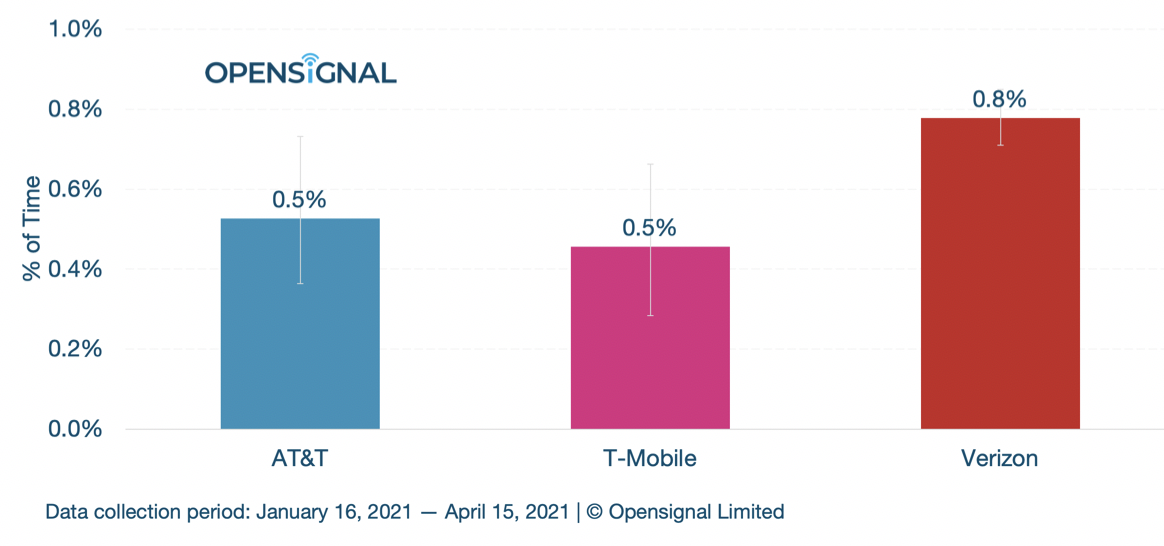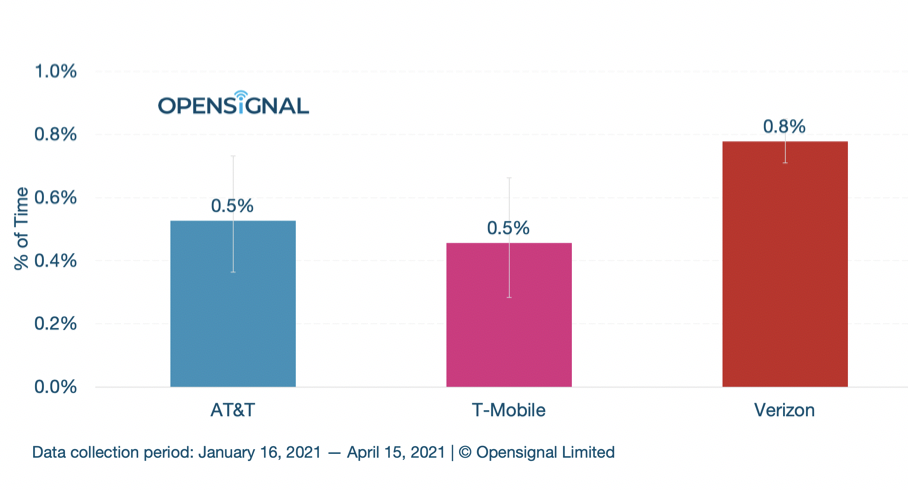Vertical Divider
mmWave: The good and the bad
An OpenSignal report shows across the full spectrum, not just mmWave, 5G availability was more healthy: 5G was available 33.1 percent of the time on T-Mobile, 20.5 percent on AT&T, and 11.2 percent of the time on Verizon. That’s down to T-Mobile focusing on “600 MHz and 2.5 GHz spectrum assets,” says the report. When connected to mmWave, at least, download speeds are ripping. mmWave 5G average download speeds were 692.9Mbps for Verizon, 232.7Mbps for AT&T, and 215.3Mbps for T-Mobile. When you can get it, it works. mmWave signals are high-frequency radio waves that don’t travel well, and are easily blocked by walls, trees, so their most likely to be useful at events, outdoors, or in malls, and on some roadways. During the cold winter, a phone sitting at home is definitely less likely to get mmWave reception. But in summer, with people outdoors, mmWave connections will happen more, and networks will continue to be rolling out antennas. But what’s been hyped with 5G and mmWave has been way overblown.
Figure 1: Average Connect Time to mmWave in US
An OpenSignal report shows across the full spectrum, not just mmWave, 5G availability was more healthy: 5G was available 33.1 percent of the time on T-Mobile, 20.5 percent on AT&T, and 11.2 percent of the time on Verizon. That’s down to T-Mobile focusing on “600 MHz and 2.5 GHz spectrum assets,” says the report. When connected to mmWave, at least, download speeds are ripping. mmWave 5G average download speeds were 692.9Mbps for Verizon, 232.7Mbps for AT&T, and 215.3Mbps for T-Mobile. When you can get it, it works. mmWave signals are high-frequency radio waves that don’t travel well, and are easily blocked by walls, trees, so their most likely to be useful at events, outdoors, or in malls, and on some roadways. During the cold winter, a phone sitting at home is definitely less likely to get mmWave reception. But in summer, with people outdoors, mmWave connections will happen more, and networks will continue to be rolling out antennas. But what’s been hyped with 5G and mmWave has been way overblown.
- There’s not a lot of reason now, and probably not a lot of reason in the next year or so, to worry about making sure the phone you pick up has mmWave connection.
- 5G generally is a little better though.
- The reality is that 5G right now is pretty much just a multiple faster than 4G LTE, if and when it’s available
- Opensignal’s global testing, the fastest average download speeds observed on any operator’s 5G service have been on Verizon’s mmWave 5G. In this analysis, the fastest average mmWave 5G download speed of 692.9 Mbps using Verizon, which was three times as fast as tests for AT&T and T-Mobile, statistically tied average download speeds on AT&T and T-Mobile’s mmWave 5G services — 232.7 Mbps and 215.3 Mbps, respectively.
- Verizon’s lead here is not surprising, given that Verizon’s 5G deployment strategy stressed mmWave while T-Mobile has focused on its 600 MHz and its 2.5 GHz spectrum assets for 5G services, and AT&T has mainly used low-band for 5G so far. Verizon holds significant quantities of mmWave spectrum and is estimated to have more than other U.S. carriers. In fact, Verizon launched its 5G service on mmWave 5G in April 2019 and only added its “Nationwide 5G” service later in October 2020 using Dynamic Spectrum Sharing (DSS) technology, which allows 5G to run simultaneously on the same spectrum band as 4G.
- AT&T was the last among the three carriers to make its mmWave 5G service available to all its consumers in March 2020, after limiting it to its business customers since the launch in December 2018. T-Mobile quickly moved its focus to deploy 5G on its low-band and mid-band frequencies after its initial 5G network launch on mmWave back in June 2019.
Figure 1: Average Connect Time to mmWave in US
Opensignal’s analytics, shows Verizon mmWave 5G users experiencing a higher average time connected to mmWave 5G than users on the other U.S. carriers. In this 90 day period, Verizon users saw a mean time connected to mmWave 5G of 0.8% compared with 0.5% on AT&T and T-Mobile. However, despite Verizon appearing to be ahead this result actually represents a statistical tie because of overlapping confidence intervals with AT&T. Despite this low score, Verizon users have seen their time connected to mmWave 5G increase over the past year. Opensignal’s data shows that Verizon still holds a significant edge in the download speeds we recorded on mmWave 5G compared to its competitors. However, despite seeing some extremely fast download and upload speeds across the mmWave 5G networks in the U.S.
Figure 2: Average Download Speed on mmWave in US
Figure 2: Average Download Speed on mmWave in US
Figure 3: Connect Time to mmWave in US
|
Contact Us
|
Barry Young
|



